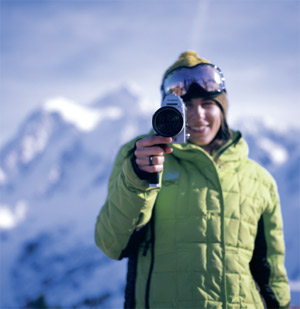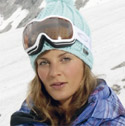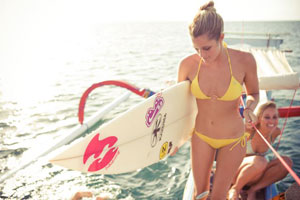Snowboard movies are as common as whoops on a powder day, but occasionally something special emerges. All-girl film Float is one such example, so we decided to quiz co-director Erin Valverde and catch up with the film’s main stars…
 How is Float different to other snowboard films?
How is Float different to other snowboard films?
It offers a unique perspective into the lives of the top women athletes of now. We portray this without much dialogue, instead using artistic imagery. There’s an underlying organic feeling that’s played out throughout the film, which is very different to the female films of the past. I know everyone always says that about their own film, but it’s true.
How do you go about planning such a film?
John Roderick (my co-producer and director) and I started off last season trying to figure out what our plan was and being frustrated at every turn. John knew he wanted to film and I knew I wanted to be filmed, but the companies we’d worked for in the past weren’t making movies that year, so we were desperately thinking of a way we could still shoot. We figured that even if no one was making a film, we could make one anyway. It was late November and we’d only just started the planning for Float. Super-last minute and unprepared, and we got Float off the ground. sponsorships were tough since it was so late in the year, but the female athletes were itching to have their shots used. and I’m so glad that we did, as otherwise the documentation of female athletes would have been reduced to only a select few. These days so many female snowboarders are killing it but they don’t yet have profiles because we never see them. Float gave us girls a chance to prove ourselves to the public and to document the amazing progression that’s taking place in women’s snowboarding.

What were the biggest challenges you faced during filming?
a lot of making a film is down to pure luck and a higher force that makes the stars align. We had lots of times when the stars were crossed or the luck just missed us, but we made it and it turned out good in the end. The season was looking good at first in the Pacific Northwest but, as a lot of you know, there were definite spots where the snow was not falling. We took advantage of down times from the lack of snowfall and filmed in the parks and streets. We had big plans to go to Europe and we also had a couple of heli trips lined up as well, which we had to back out of due to Mother Nature once again. The hardest part is trying to chase the snow and weather. It’s go-time if you hear of a storm, whether you’re ready or not.
Another tough thing about last season was the amount of injuries that the girls encountered. Maribeth Swetkoff broke her leg, Chanelle Sladics hurt her back, Silvia Mittermuller blew out her knee, and Laura Hadar and Caroline Beliard also hurt their knees. All of these girls still got amazing shots, but it’s stressful for the riders, filmers and sponsors when these things happen.
Why is this film so important for the women’s snowboarding scene?
Female snowboard films have progressed so much, and they’re super-important for the industry. Films and magazines promote snowboarding to girls around the world, and encourage them to get into the sport and realise that not only guys can do 720s off huge jumps. Girls and guys love to see the riding ability of the top athletes and to use it as inspiration. Nowadays the women’s market is rising due to all of us showing them that it is possible.

What’s your favourite time of day to film?
There are important times to go out and get the shots. When there’s powder, it’s especially good to get out there as early as possible. Dawn patrol always seems to be rewarding. The park is usually good at any time of day, but I like the look of sunset park riding, or when the sun is lowered just enough to give the snow and trees that really nice alpine glow. But it’s good to film all day long to get as much material as possible.
What tips do you have for budding snowboard film-makers?
You have to devote yourself 110 per cent to the project. Film everything that you think could possibly be used in the film and find people that are not only good athletes, but have good attitudes too. We were super-lucky that the girls in the film had beautiful and unique personalities. Marketing and communications skills are good for dealing with sponsors and media. I’ve learnt a lot by calling all the companies I thought would be a good fit. It was hard but rewarding at the same time, and we couldn’t have done this film without them.
Thanks to everyone that helped us along the way… you know who you are.
But how was the Float experience for the rippers on the other side of the camera?
We get the pro views…

Silvia Mittermüller
How is Float different?
It isn’t as sponsor-politics-driven as other girl movies. It only happened because of passion and dedication to snowboarding. We had a fun crew and everyone was invited to come to every trip. It was also an open-minded movie, it wasn’t just about high-tech snowboarding, it was about the personalities, the whole lifestyle, like going to different countries, and all the experiences we had last season.
What’s your favourite sequence in the movie?
I really love the China and Japan sections. China was just such a crazy experience in itself, and in Japan I had the best powder tree runs of my whole life. But I also really like the Colorado section, because that’s where I’ve been living the last few years and I deeply love that place.
What was the most fun you had?
Wow, that’s hard to say, but the highest ollie contest in China was one of the highlights of my entire season. There was such a pure, happy atmosphere, with so much stoke and excitement for such a small thing as jumping over a pole!

What was the best jib feature you rode?
Hmm, we had a really sweet shoot in the Canyons, where they set up a lot of really fun boxes for us. We also did a really good ledge there, and the mushroom garbage bins in China were a ton of fun too.
Why is the film so important for the women’s snowboarding scene?
Because it shows the fun to be had in so many different ways, there’s stuff in the movie that everyone can connect to. It represents a broad range of ways of snowboarding and attitudes, so I hope everyone will find something they like in it.
What is one of the biggest challenges of being filmed?
When the filmer pulls out the 16mm camera, because then you know that you shouldn’t fall on your arse anymore! (For those that don’t know developing 16mm film is really expensive.)

Jamie Anderson
How is Float different?
It’s more about the trips and everything that goes into them, rather than just back-to-back sequences of us riding. It really shows us riding in different parts of the world, mixed with some more mellow stuff – it’s rad!
What’s your favourite sequence in the movie?
I really liked the Japan section, it was a lot of fun riding with a lot of fun people.
What was the best jib feature you rode?
Um, I don’t jib too much, but I liked the little down flat down I did.

Why is the film so important for the women’s snowboarding scene?
So other people know that girls are trying really hard too, it takes a lot of effort to make a snowboard film.
What is the biggest challenge of being filmed?
It’s really hard having a camera around, it either makes you ride better or it makes you ride worse, which sucks, but you can get over it.
 Lisa Filzmoser
Lisa Filzmoser
How is Float different?
It’s filmed and produced by one film-maker John Roderick, and rider Erin Valverde. So it’s really low budget but is going to be really widely known.
Where was the best place you filmed?
It was really cool to get to know Mt Baker. It’s an amazing resort, where you have good backcountry with easy access to drops, cliffs and fun rides. For sure the powder day there was most fun.
What was the best jib feature you rode?
I’m not that into jibbing, but did my first street rail and ledge in Park City. Yeeha!

Why is the film so important for the women’s snowboarding scene?
Because it shows some good and fun riding, and girls wanna see girls ride.
What is the biggest challenge of being filmed?
The weather. Sometimes you can wait for days or weeks for good snow or sunny days.

Barrett Christy
How is Float different?
It really gives you an insight into the lifestyle. It’s not just the shots that resulted from a season of shredding, but it’s about the experience. Float captures the life of a variety of girls at different stages of their careers. I was inspired by all the girls in the film, they are keeping it fun and contributing to the progression of women’s snowboarding.
What’s your favourite sequence in the movie?
I’m biased, but I loved the Northwest shots. The pillow lines that Erin did and the pow shots of Lisa and Meghann.
Where was the best place you filmed?
I spent a day at Baker with Lisa and Erin cruising around on some of my favourite runs. Baker is a tough place to film because it’s seriously hard to slow down and do what it takes to capture the moment. The segment that they put together of me was pretty special, I’m very proud and honoured to be included.
What was the most fun you had?
I love a powder day above all other days, but I did go to Ms Superpark at Mammoth and got to watch the girls ride. There are always a few girls who take the lead and set the standard high. Lisa was going huge on the hip jump, and I think she set the high mark on that one.
Why is the film so important for the women’s snowboarding scene?
I think it’s really important for women to have these projects to work on. There aren’t many opportunities for filming with the major productions, and it’s what up-and-coming girls use to set their standards. Girls at every level look up to the pros to see what is possible. I think that’s why girls are so good now, and how they step right up to big jumps and crazy jibs without years of experience behind them. The more they see girls getting out there and doing it, the more it seems possible and those goals are accessible.
Want to know what all the fuss is about? Watch the Float teaser here…

